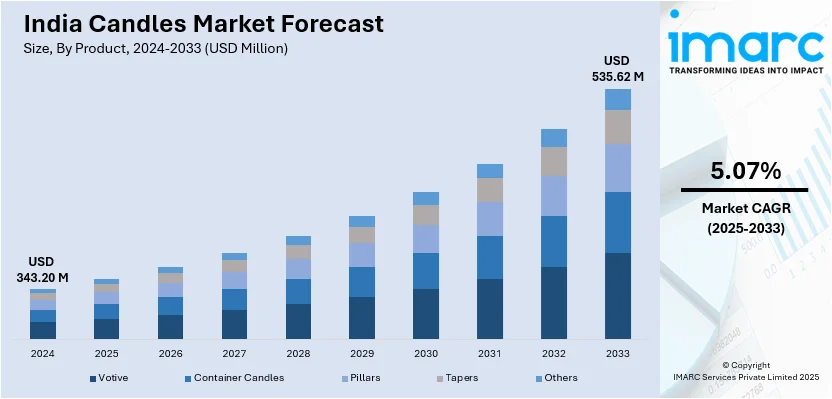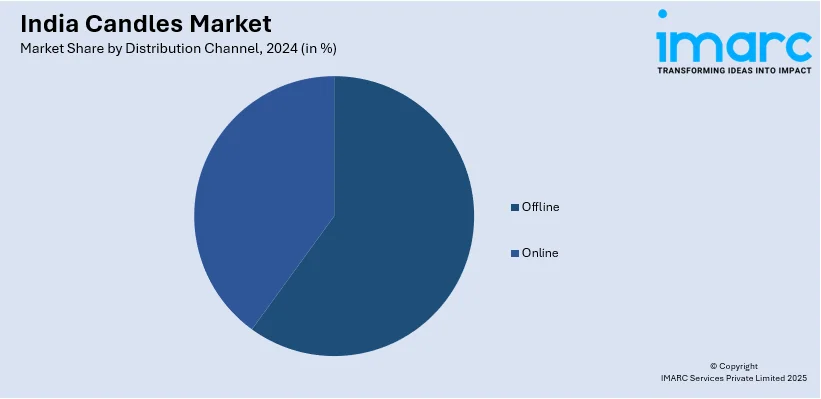
India Candles Market Size, Share, Trends and Forecast by Product, Wax Type and Distribution Channel, and Region, 2025-2033
India Candles Market Overview:
The India candles market size reached USD 343.20 Million in 2024. Looking forward, IMARC Group expects the market to reach USD 535.62 Million by 2033, exhibiting a growth rate (CAGR) of 5.07% during 2025-2033. The market is expanding due to rising demand for aromatherapy, decorative and ecofriendly candles. Growth in online retail, premium handcrafted products and sustainable wax alternatives is driving market growth across the country.
|
Report Attribute
|
Key Statistics
|
|---|---|
|
Base Year
|
2024 |
|
Forecast Years
|
2025-2033
|
|
Historical Years
|
2019-2024
|
| Market Size in 2024 | USD 343.20 Million |
| Market Forecast in 2033 | USD 535.62 Million |
| Market Growth Rate 2025-2033 | 5.07% |
India Candles Market Trends:
Expansion of Online Retail and E-Commerce
The expansion of online retail and e-commerce is significantly transforming the India candles market providing consumers with a wide range of customizable, artisanal and premium candles. According to the data published by IBEF, India's e-commerce market is projected to reach US$ 325 billion by 2030 fueled by 500 million shoppers. The sector achieved US$ 60 billion in FY23 with a 22% increase. B2B e-commerce could hit US$ 200 billion by 2030. The increasing preference for online shopping, along with the convenience of doorstep delivery, seasonal discounts and direct-to-consumer (D2C) brand expansions, is driving higher candle sales across digital platforms. These factors are contributing to the India candles market share as brands leverage e-commerce to reach a broader consumer base and offer personalized products. Digital platforms offer a seamless shopping experience allowing customers to explore diverse designs, fragrances and wax types including soy, beeswax and coconut wax candles. The rise of D2C (Direct-to-Consumer) brands and independent artisans on platforms like Amazon, Flipkart and Instagram has fueled the growth of handcrafted, decorative and personalized candles. Ecommerce enables manufacturers to offer limited-edition, seasonal and themed candles tailored for festivals, weddings and gifting purposes. Competitive pricing, bulk discounts and doorstep delivery enhance consumer accessibility. AI-driven recommendations, influencer marketing and social media promotions further boost online candle sales. With growing internet penetration and digital payment adoption ecommerce continues to be a key driver of India candles market growth.

Growth of Eco-Friendly and Sustainable Candles
The Indian candles market is witnessing a surge in demand for ecofriendly and sustainable candles driven by rising environmental consciousness and consumer preference for natural and non-toxic alternatives. Soy wax, beeswax and coconut wax candles are gaining popularity due to their clean-burning properties, longer lifespan and biodegradability. Consumers are actively shifting away from paraffin-based candles which emit harmful pollutants toward organic and chemical-free options. Leading brands and independent artisans are innovating with zero-waste packaging, lead-free cotton wicks and cruelty-free production methods. For instance, in November 2024, Aurawick a luxury brand known for handmade candles sold out its entire collection within 48 hours of launch. Crafted from ecofriendly materials and featuring reusable bar-quality glassware these candles merge elegance with sustainability. Demand reflects a growing interest in high-quality unique home decor items, prompting plans for stock replenishment. The trend is further supported by the growing popularity of aromatherapy, wellness products and handmade artisanal candles. With increasing awareness and regulatory support for sustainable products the market for ecofriendly candles in India is expected to expand significantly in the coming years. These factors, including consumer demand for natural alternatives, innovation in sustainable packaging, and the rise of premium handcrafted candles, are creating a positive India candles market outlook driving growth and new opportunities in the sector.
India Candles Market Segmentation:
IMARC Group provides an analysis of the key trends in each segment of the market, along with forecasts at the regional level for 2025-2033. Our report has categorized the market based on product, wax type and distribution channel.
Product Insights:
- Votive
- Container Candles
- Pillars
- Tapers
- Others
The report has provided a detailed breakup and analysis of the market based on the product. This includes votive, container candles, pillars, tapers and others.
Wax Type Insights:
- Paraffin
- Soy Wax
- Beeswax
- Palm Wax
- Others
A detailed breakup and analysis of the market based on the wax type have also been provided in the report. This includes paraffin, soy wax, beeswax, palm wax and others.
Distribution Channel Insights:

- Offline
- Online
A detailed breakup and analysis of the market based on the distribution channel have also been provided in the report. This includes offline and online.
Regional Insights:
- North India
- South India
- East India
- West India
The report has also provided a comprehensive analysis of all the major regional markets, which include North India, South India, East India and West India.
Competitive Landscape:
The market research report has also provided a comprehensive analysis of the competitive landscape. Competitive analysis such as market structure, key player positioning, top winning strategies, competitive dashboard, and company evaluation quadrant has been covered in the report. Also, detailed profiles of all major companies have been provided.
India Candles Market News:
- In November 2024, Diptyque, renowned for its luxury perfumes and candles, announced the launch of its first store in India at The Chanakya, New Delhi. The company emphasizes the brand's connection to India's rich fragrance culture aiming to provide a unique sensory experience while facing the challenge of blending with local scent traditions.
- In September 2023, Seva Home launched a limited-edition candle collection in collaboration with renowned artist Suryakant Lokhande, featuring the Maharaja and Maharani candles. The Maharaja candle, scented with “Aqua,” while the Maharani candle, infused with “Berries".
India Candles Market Report Coverage:
| Report Features | Details |
|---|---|
| Base Year of the Analysis | 2024 |
| Historical Period | 2019-2024 |
| Forecast Period | 2025-2033 |
| Units | Million USD |
| Scope of the Report | Exploration of Historical Trends and Market Outlook, Industry Catalysts and Challenges, Segment-Wise Historical and Future Market Assessment:
|
| Products Covered | Votive, Container Candles, Pillars, Tapers, Others |
| Wax Types Covered | Paraffin, Soy Wax, Beeswax, Palm Wax, Others |
| Distribution Channels Covered | Offline, Online |
| Regions Covered | North India, South India, East India, West India |
| Customization Scope | 10% Free Customization |
| Post-Sale Analyst Support | 10-12 Weeks |
| Delivery Format | PDF and Excel through Email (We can also provide the editable version of the report in PPT/Word format on special request) |
Key Questions Answered in This Report:
- How has the India candles market performed so far and how will it perform in the coming years?
- What is the breakup of the India candles market on the basis of product?
- What is the breakup of the India candles market on the basis of wax type?
- What is the breakup of the India candles market on the basis of distribution channel?
- What is the breakup of the India candles market on the basis of region?
- What are the various stages in the value chain of the India candles market?
- What are the key driving factors and challenges in the India candles market?
- What is the structure of the India candles market and who are the key players?
- What is the degree of competition in the India candles market?
Key Benefits for Stakeholders:
- IMARC’s industry report offers a comprehensive quantitative analysis of various market segments, historical and current market trends, market forecasts, and dynamics of the India candles market from 2019-2033.
- The research report provides the latest information on the market drivers, challenges, and opportunities in the India candles market.
- Porter's five forces analysis assist stakeholders in assessing the impact of new entrants, competitive rivalry, supplier power, buyer power, and the threat of substitution. It helps stakeholders to analyze the level of competition within the India candles industry and its attractiveness.
- Competitive landscape allows stakeholders to understand their competitive environment and provides an insight into the current positions of key players in the market.
Need more help?
- Speak to our experienced analysts for insights on the current market scenarios.
- Include additional segments and countries to customize the report as per your requirement.
- Gain an unparalleled competitive advantage in your domain by understanding how to utilize the report and positively impacting your operations and revenue.
- For further assistance, please connect with our analysts.
 Inquire Before Buying
Inquire Before Buying
 Speak to an Analyst
Speak to an Analyst
 Request Brochure
Request Brochure
 Request Customization
Request Customization




.webp)




.webp)












